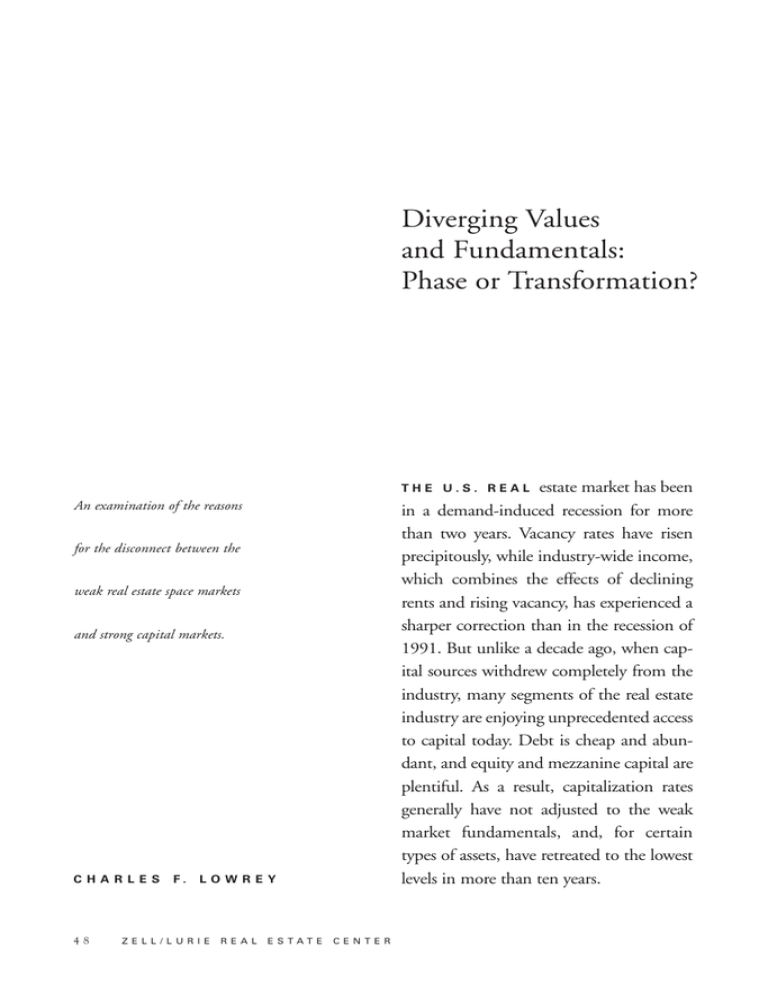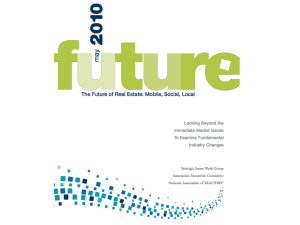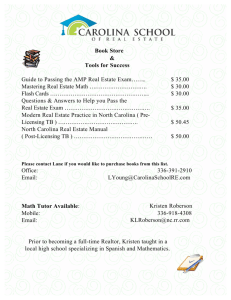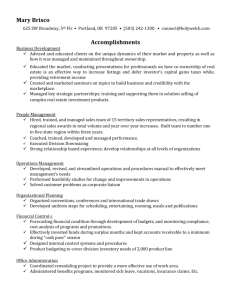Diverging Values and Fundamentals: Phase or Transformation?
advertisement

Diverging Values and Fundamentals: Phase or Transformation? estate market has been in a demand-induced recession for more than two years. Vacancy rates have risen precipitously, while industry-wide income, which combines the effects of declining rents and rising vacancy, has experienced a sharper correction than in the recession of 1991. But unlike a decade ago, when capital sources withdrew completely from the industry, many segments of the real estate industry are enjoying unprecedented access to capital today. Debt is cheap and abundant, and equity and mezzanine capital are plentiful. As a result, capitalization rates generally have not adjusted to the weak market fundamentals, and, for certain types of assets, have retreated to the lowest levels in more than ten years. THE U.S. REAL An examination of the reasons for the disconnect between the weak real estate space markets and strong capital markets. CHARLES 48 F. LOWREY ZELL/LURIE REAL ESTATE CENTER A confluence of forces—both secular and transitory—has created this apparent disconnect between the weak real estate space markets and strong capital markets. This paper examines the capital market forces, supply/demand dynamics and demographic changes that have contributed to the apparent disparity between pricing and fundamentals. It concludes that while some features of the current environment are more cyclical than secular, others will be part of the new normalcy in the market, since they are a reflection of long-term fundamental forces. SYMPTOMS THE erty market fundamentals in most markets and sectors have weakened significantly, and, in some cases, will probably worsen before they improve. Yet equity and debt capital are readily available for a broad spectrum of real estate investments, with some important exceptions, from a wide variety of public and private institutional and individual capital sources. For properties in the “sweet spot” of the market—core assets with secure cash flows of long duration and high quality—capital is also remarkably inexpensive (which helps explain why wellleased, income-producing assets often trade above replacement cost). Intuition suggests that these conditions should not coincide, or at least should not persist for any extended period. But this is precisely what has been happening in the real estate market for more than two years. The symptoms of the weak space markets OF DISCONNECT The disconnect in the real estate market is undeniable. Over the past two years, propFigure 1: Growth of Real Estate Income 10% Forecast 8% 6% 4% 2% 0% -2% -4% -6% -8% 07 06 20 20 05 04 20 03 20 20 02 01 20 00 20 99 20 97 98 19 19 96 19 95 94 92 93 19 19 19 19 91 19 19 19 90 -10% Note: Real estate is weighted 35% office, 25% retail, 25% apartment, 10% warehouse, and 5% hotel. Sources: Property & Portfolio Research; Prudential Real Estate Investors REVIEW 49 Figure 2: Apartment Cap Rates Based on Four-Quarter Trailing Income Apartment Sector NCREIF Property Index 9.0% 8.5% 8.0% 7.5% 7.0% 6.5% 02 20 00 20 98 19 96 19 4 19 9 2 19 9 0 19 9 88 19 86 19 84 19 82 19 80 19 19 78 6.0% Sources: NCREIF; Prudential Real Estate Investors are obvious. Tenant demand for most property types, with the notable exception of the consumer-driven retail sector, fell sharply after the tech bubble burst in March 2000 and the economy fell into recession. The office market, which is closely tied to the corporate economy, was hit particularly hard and experienced unprecedented negative absorption. Weak tenant demand caused vacancy rates to soar and rents to fall. The combined effects of these adverse space market conditions is illustrated clearly in the steep decline in the overall income growth rates for the real estate industry. As shown in Figure 1, income growth turned sharply negative in 2001 and is not expected to resume positive growth until the second half of 2004. 50 ZELL/LURIE REAL ESTATE CENTER Evidence of the strong capital markets in the transactions market, however, is just as obvious and incontrovertible. Despite the weaker property market fundamentals, capitalization rates have continued to trend lower, especially in the apartment sector (Figure 2). While some of the decline in cap rates is due to falling income, asset prices have generally not adjusted to the weaker market conditions. The declining cap rates underscore the intense investor demand for well-leased, income-producing core real estate assets as well as the remarkable liquidity in the market. Offerings of core properties frequently attract numerous bidders—often as many as 20 or 30 potential qualified buyers—and competition among buyers has pushed prices for many assets well above replacement costs, even as local market vacancy rates have continued to climb. Theoretically, capital should become more expensive and scarcer as the risk associated with an investment increases. But just the opposite seems to have recently occurred in the real estate market. Despite the weaker property market conditions, liquidity abounds and asset pricing is rich. Although many factors ultimately will determine how long this disconnect persists, capital market forces, property market dynamics and demographic changes provide some explanation for why the disconnect developed and what features, if any, will endure. C A P I TA L MARKET FORCES The capital markets always exert a strong influence on the real estate industry. After all, real estate is a capital-intensive business, which, because of the highly financeable nature of the assets, is financed largely with debt. It should not be surprising, therefore, that capital market forces— interest rates and the cost of debt in particular—not only affect real estate pricing, but at times may even overwhelm other powerful forces, such as property market fundamentals. This certainly has been the case in recent years due to several unusual features in the real estate and broader capital markets. Figure 3: : Mortgage Rates and 10-Year Treasury Bonds Prime Mortgage Rates 9% 10-Year Treasury Yields 8% 7% 6% 5% 4% -9 6 n9 D 7 ec -9 Ju 7 n9 D 8 ec -9 Ju 8 n9 D 9 ec -9 Ju 9 n0 D 0 ec -0 Ju 0 n0 D 1 ec -0 Ju 1 n0 D 2 ec -0 Ju 2 n03 Ju ec D n- Ju D ec -9 5 96 3% Sources: Barrons; John B. Levy & Co.; Prudential Real Estate Investors REVIEW 51 The most obvious and important feature, of course, has been the steep decline in mortgage rates. Benchmark interest rates have fallen sharply since the stock market collapsed and the economy fell into recession nearly three years ago. The Fed’s efforts to resuscitate the ailing economy pushed short-term rates to their lowest levels in more than 40 years. The yield on 10-year Treasury bonds dropped to a meager 3.1 percent in mid-June 2003 before climbing to about 4.2 percent by the end of the year (Figure 3). While mortgage rates, not surprisingly, tumbled along with the benchmark rates, tighter mortgage spreads (the difference Figure 4: AAA-Rated 10-Year CMBS Less 10-Year Treasuries 210 basis points (bps) 190 170 150 130 110 90 70 280 0 Ja n01 Ju l-0 1 Ja n02 Ju l-0 2 Ja n03 Ju l-0 3 Ja n04 0 l-0 Ju 9 Ja n0 9 l-9 Ju 8 Ja n9 8 l-9 Ju 7 n9 l-9 Ja Ja Ju n97 50 Prime Mortgage Rate Less 10-Year Treasury Yield 260 basis points (bps) 240 220 200 180 160 140 120 n97 D ec -9 7 Ju n98 D ec -9 8 Ju n99 D ec -9 9 Ju n00 D ec -0 0 Ju n01 D ec -0 1 Ju n02 D ec -0 2 Ju n03 Ju -9 6 96 ec D n- Ju D ec -9 5 100 Sources: Barrons; John B. Levy & Co.; Bloomberg; Prudential Real Estate Investors 52 ZELL/LURIE REAL ESTATE CENTER between mortgage rates and benchmark interest rates) further reduced the cost of real estate debt. Mortgage spreads narrowed more or less steadily from mid-2001 through 2003. Over the past two years, spreads between prime mortgage rates and the yield on 10-year Treasury bonds have fallen from about 230 basis points to about 160 basis points. The spread compression in the public debt markets, between commercial mortgagebacked securities (CMBS) and 10-year Treasury bonds, has been even more dramatic. As recently as June 2000, yields on AAA-rated CMBS were 180 basis points higher than the yield on the 10-year Treasury bonds, but have since narrowed to about 70 basis points (Figure 4). From a real estate perspective, tighter spreads in an environment of deteriorating property market conditions confirm the disconnect between the real estate property and capital markets. Indeed, competition among lenders eager to place capital has intensified over the past two years despite the weaker market conditions. However, when viewed against the broader investment universe, the narrower spreads demonstrate the increasingly close ties between the real estate and broader capital markets. The sharp rise in corporate defaults from 1999 through 2002, which included spectacular failures of “too big to fail” companies such as Enron and WorldCom, and widespread corporate scandals caused corporate bond spreads to widen while mortgage delinquencies remained near historic lows (Figure 5). Low mortgage rates can and do affect asset pricing, however, particularly when rates fall far enough to create a positive spread between current cash yields and the Figure 5: Commercial Mortgage Delinquency and Corporate Bond Default Rates Commercial Mortgages Corporate Bonds 8% 7% 6% 5% 4% 3% 2% 1% 19 88 19 88 19 89 19 90 19 91 19 91 19 92 19 93 19 94 19 94 19 95 19 96 19 97 19 97 19 98 19 99 20 00 20 00 20 01 20 02 20 03 0% Sources: ACLI; Moody’s; Prudential Real Estate Investors REVIEW 53 Figure 6: NCREIF Cash Yield vs. 10-Year Treasury NCREIF 10-Year Treasury 16% 14% 12% 10% 8% 6% 4% ec -8 1 ec -8 D 2 ec -8 D 3 ec -8 D 4 ec -8 D 5 ec -8 D 6 ec -8 D 7 ec -8 D 8 ec -8 D 9 ec -9 D 0 ec -9 D 1 ec -9 D 2 ec -9 D 3 ec -9 D 4 ec -9 D 5 ec -9 D 6 ec -9 D 7 ec -9 D 8 ec -9 D 9 ec -0 D 0 ec -0 D 1 ec -0 2 9 D 0 ec D D -8 -7 -7 ec D D ec 8 2% Note: Cash yield for NCREIF is based on income return less an allowance for capital expenditures. Sources: NCREIF; Bloomberg; Prudential Real Estate Investors cost of debt. Cash yields from unleveraged, core real estate assets, as measured by the NCREIF Property Index, have remained relatively stable since the mid-1990s and are currently around 6 percent. As mortgage rates declined below 6 percent, the positive yield spread between current cash yields and the cost of debt allowed (and encouraged) investors to use leverage to boost their current returns on equity (Figure 6). But the increased use of leverage and the positive yield spread have also allowed investors to pay higher prices for assets. Because the leveraged cash yields account for a significant portion of the total return on these types of investments, investors can effectively amortize a surprisingly large decline in property values over the holding 54 ZELL/LURIE REAL ESTATE CENTER period and still realize a competitive return. This, in turn, allows investors to pay a premium over replacement cost for prime assets to secure current cash yields. As the economic recovery progresses, it seems likely that interest rates will rise, putting upward pressure on mortgage rates. Even a modest increase in interest rates could neutralize the positive yield spread. Mortgage spreads could widen as well if the space market remains weak or the corporate bond market becomes relatively more attractive to fixed-income investors who have sought refuge in real estate. If mortgage spreads widen and/or rising interest rates cause mortgage rates to increase further, the disconnect between asset pricing and market fundamentals should narrow or disappear as investors, Figure 7: Difference Between Value and Growth, Trailing 12-mo. Returns 50% 40% 30% 20% 10% 0% -10% -20% -30% -8 6 ec -8 D 7 ec -8 D 8 ec -8 D 9 ec -9 D 0 ec -9 D 1 ec -9 D 2 ec -9 D 3 ec -9 D 4 ec -9 D 5 ec -9 D 6 ec -9 D 7 ec -9 D 8 ec -9 D 9 ec -0 D 0 ec -0 D 1 ec -0 2 -8 5 D ec D -8 4 ec D -8 3 ec D -8 2 ec D -8 1 ec D -8 0 ec D ec D D ec -7 9 -40% Note: Russell 3000 Value less Russell 3000 Growth. Sources: Ibbotson Associates; Prudential Real Estate Investors no longer compensated by leveraged cash flow returns, become less willing to pay premium prices. Investor sentiment has also contributed to the strong demand for real estate investments, despite the weaker market conditions. Within the broader investment universe, real estate (including public REITs) is viewed as a value investment due to the relatively high cash yields and lower volatility of real estate returns. The bursting of the tech bubble and subsequent collapse of the stock market caused a dramatic rotation out of growth-oriented investments and into value investments like real estate. As Figure 7 illustrates, the collapse of the tech market in March 2000 precipitated an abrupt and dramatic shift from growth to value. In February 2001, near the peak of the public equity markets, growth stocks in the Russell 3000 Index had outperformed value stocks in the Index by more than 37 percent on a trailing 12-month basis. Over the next 12 months, however, as investors rotated out of growth investments, value stocks outperformed growth stocks by an average margin of nearly 50 percent! The REIT market rallied, the housing market boomed, and commercial real estate investors of all types—institutional, private buyers, foreign sources, etc.— increased (or initiated) allocations to real estate. Market rotations are not uncommon, of course. Although investor sentiment, like mortgage rates, has contributed to the strong demand for real estate, preliminary evidence from the stock market suggests REVIEW 55 that it too will be a cyclical phenomenon. Investor sentiment shifted back toward growth for most of 2003. If value investments lose favor, the excess liquidity in the capital markets will dry up. The effects of a change in investor sentiment may not be as dramatic as what might unfold if interest rates were to rise sharply. However, it should alleviate some of the intense competition among investors in the transactions market and lenders in the debt market, which has caused pricing to deviate from market fundamentals. Other features of the capital markets may be more enduring. Most investors have re-examined and revised their expected return forecasts for all asset classes. Although this includes real estate, the relatively weak outlook for stocks and bonds makes real estate returns attractive. To illustrate, assume the economy resumes a more normal nominal growth rate of 5 percent to 6 percent, and corporate earnings growth approximates the nominal growth rate for the broader economy. In such an environment, the total return for stocks should be between 7 percent and 8 percent per year, assuming stocks continue to deliver dividend yields of about 1.7 percent (the average dividend yield for the S&P 500 as of year-end 2003). This expected return range also assumes, of course, that P/E ratios remain constant. While an increase in P/E ratios would cause the returns for stocks to be higher, 56 ZELL/LURIE REAL ESTATE CENTER the average P/E ratio is already significantly higher than the long-term historical average of 15x. If P/E ratios revert to their long-term average, stock market returns would be even lower. Bond market returns could also be relatively weak. With the yield on 10-year Treasury bonds around 4.2 percent as of year-end 2003, investment-grade bonds would be expected to return between 5.5 percent and 6 percent, assuming a 150 basis point spread for high-quality corporate bonds and no further increases in interest rates. The expected returns from bonds would be higher, of course, if interest rates fall, which seems unlikely, but would suffer if interest rates rise. Real estate returns may also decline as the supply and demand for space move back into balance and income growth gradually recovers. But even with a 6 percent cash yield and modest inflationary growth in asset values, say about 2 percent per year, the expected returns from core real estate look attractive, especially on a risk-adjusted basis. Thus, as long as the outlook for stocks and bonds remains relatively weak and real estate market conditions do not deteriorate significantly further, investors’ lower return expectations should continue to favor real estate investments. Structural changes in the real estate capital markets should also be an enduring positive force. The real estate capital markets have undergone a remarkable transformation over the past ten to 15 years. With the development of the CMBS market and the growth of the public REIT market, the industry’s capital sources are far more diverse than they were during the downturn a decade ago, and transparency is greatly improved. Theoretically, more capital sources and greater transparency should ensure more efficient access—in terms of both pricing and availability—to equity and debt capital. Similarly, the proliferation and increasing sophistication of investment strategies and vehicles should, in theory, provide a more rational allocation of capital due to better alignment between investors’ objectives and investment strategies. How much these structural changes will affect asset pricing depends, in part, on whether capital sources respond to these changes. If they do, they will reward the industry with a lower cost of capital. A more efficient and rational allocation of capital should be a positive, long-term feature of the real estate capital markets. Finally, in an efficient market, pricing is always forward looking. As Figure 1 illustrates, income growth for the real estate industry is expected to begin to recover in late 2004. As competition for deals intensifies in anticipation of the recovery, cap rates based on trailing, and often depressed, income should actually fall. Not everyone agrees on the speed and/or shape of the recovery, however. While the industry consensus expects a modest recovery, individual expectations Figure 8: Hotel Revenue Per Available Room (RevPAR) Growth 15% PPR Torto-Wheaton 10% 5% 0% -5% -10% -15% Forecast -20% 19 89 : 19 1 90 : 19 1 91 : 19 1 92 : 19 1 93 : 19 1 94 : 19 1 95 : 19 1 96 : 19 1 97 : 19 1 98 : 19 1 99 : 20 1 00 : 20 1 01 : 20 1 02 : 20 1 03 : 20 1 04 : 20 1 05 : 20 1 06 : 20 1 07 :1 -25% Sources: Property & Portfolio Research; Torto Wheaton Research; Prudential Real Estate Investors REVIEW 57 vary from pessimistic comparisons to 1991 to optimism for a sharp and dramatic rebound after 2004. Forecasts for the hotel industry from PPR and Torto Wheaton Research illustrate this point (Figure 8). While Torto Wheaton expects hotel revenue per available room (RevPAR) will grow more than 7 percent in the near future, Property & Portfolio Research expects less than half as much. The current operating situation in the hotel industry is still very weak. Although room demand was much stronger in 2002 than in 2001, persistently weak demand over the past two years has made it virtually impossible to underwrite hotels based on trailing income. Instead, deals are being underwritten based on forward net operating income (NOI) or some measure of normalized NOI. Such anticipatory buying by the more optimistic investors has contributed to the disconnect between the weak space market and strong capital market by driving down cap rates based on current income. PROPERTY MARKET FORCES Although capital market forces are largely responsible for the disparity between asset pricing and property market fundamentals, a few features of the property markets have also contributed to the apparent disconnect. Notably, the bifurcation in the 58 ZELL/LURIE REAL ESTATE CENTER transactions market may give the appearance that market capitalization rates are trending lower (or holding steady), when in reality many assets probably do not possess the characteristics that command premium pricing today. The liquidity in the market today is concentrated on core assets that offer relatively attractive cash yields with term and credit, but little demand exists for assets that lack any of these qualities. As a result, many of the transactions that have been completed over the past two years reflect a selection bias that may contribute to the apparent disconnect. The lack of transaction data for noncore assets—properties that suffer from vacancy and/or credit quality issues— makes it difficult to know for certain whether or not this is the case. Anecdotally, however, very little demand appears to exist for properties that do not offer secure cash yields, at least not at the current pricing levels. Where underwriting uncertainty exists, buyers and sellers are often unable to reach an agreement on pricing in part because, unlike a decade ago, relatively few property owners are under pressure to sell. Better underwriting, lower leverage, and healthier balance sheets on the part of many property owners have helped limit the amount of distress in the market today. Thus, many would-be sellers have taken advantage of the low mortgage rates and readily available capital to refinance and try to weather the downturn rather than sell their properties into the uncertain transaction market. Somewhat ironically, investors’ generally favorable perception of the current space market weakness is also contributing to the disparity between pricing and fundamentals. Unlike the real estate recession a decade ago, when years of excess new supply caused soaring vacancy rates, most investors today rightfully believe the current market downturn was the result of the sudden collapse in demand that coincided, more or less, with the bursting of the tech bubble. Although new supply clearly was gaining momentum when demand contracted, the rate of supply growth was not too far out of line with demand, and was considerably lower than during the mid-1980s. Whereas investors viewed the downturn in the early ’90s as evidence of structural flaws inherent in the real estate industry, most believe external factors are largely responsible for the current space market weakness. While the net effect of this more favorable perception may be subtle, investors seem willing to discount the current weakness in the property markets rather than abandon the asset class altogether (as they did in droves a decade ago). As a result, asset values have not plummeted as vacancy rates have risen and rents have declined. Unfortunately, when demand began to contract in 2000, the natural lag in the development pipeline inevitably led to excess supply in many markets and sectors, which, together with the sharp decline in demand, caused vacancy rates to rise nearly Figure 9: Supply Growth as a % of Total Stock Office Weighted Real Estate 7% 6% Forecast 5% 4% 3% 2% 1% 19 82 19 83 19 84 19 85 19 86 19 87 19 88 19 89 19 90 19 91 19 92 19 93 19 94 19 95 19 96 19 97 19 98 19 99 20 00 20 01 20 02 20 03 20 04 20 05 20 06 20 07 0% Note: Real estate is weighted 35% office, 25% retail, 25% apartment, 10% warehouse, and 5% hotel. Sources: Property & Portfolio Research; Prudential Real Estate Investors REVIEW 59 to the levels seen during the early 1990s. Too much space is too much space, regardless of whether it resulted from excess supply or insufficient demand. Tenant demand will eventually recover, of course, and the inevitable recovery should cause the bifurcation in the transaction market to disappear as investors consider properties that fall outside their comfort zone today. But the favorable perception of the market downturn may ultimately prove to be bitter comfort. DEMOGRAPHIC temporary feature of the real estate investment market, demographic changes will endure for at least the next decade. The U.S. population is getting older. People are living longer, and the massive baby boom generation is moving steadily, if reluctantly, toward retirement. A consequence of the aging population will be a gradual shift away from lowyielding growth investments toward lower-risk, higher-yielding ones. This should favor investments that offer relatively high, stable cash yields, like real estate. Real estate should also benefit from the incremental demand created by the baby boomers’ children, the echo boomers, who were born between 1977 and 1998. The CHANGES While the property market forces that contribute to the disconnect may be a Figure 10: % Change by Age Category of US Population 1990-2000 95+ 90-94 85-89 80-84 75-79 70-74 65-69 60-64 55-59 50-54 45-49 40-44 35-39 30-34 25-29 20-24 15-19 10-14 5-9 <5 34.7% 44.6% 35.4% 25.7% 21.1% 10.8% -5.7% 1.8% 27.9% 54.9% 44.8% 27.4% 13.7% -6.2% -9.1% -0.3% 13.9% 19.9% 13.5% 4.5% -20% -10% 0% 10% 20% Sources: U.S. Census Bureau; Prudential Real Estate Investors 60 ZELL/LURIE REAL ESTATE CENTER 30% 40% 50% 60% Figure 11: US Population Age 20-24 (millions) 25.0 22.5 20.0 17.5 Forecast 15.0 12.5 10.0 1963 1968 1973 1978 1983 1988 1993 1998 2003 2008 2013 2018 2023 Sources: U.S. Census Bureau; Prudential Real Estate Investors echo boom generation, which at roughly 80 million people is similar in size to their parents’ generation but spans a broader age range, will be a significant source of demand for all types of real estate over the next two decades. The large size of this generation helps explain why the household and employment growth rates are expected to exceed the population growth rate for at least the next decade. The oldest echo boomers are now 26 and are already part of the workforce. Based on estimates from the 2000 Census, more than 3.9 million echo boomers will turn 21 each year between 2003 and 2016, peaking at nearly 4.3 million in 2012. The high propensity to rent among this segment of the population should create tremendous demand for housing long after the youngest echo boomers enter the workforce. This fact undoubtedly has contributed to the recent strength in the apart- ment market, where the disconnect between the real estate space and capital markets is widest. But echo boomers’ entry into the workforce will also create demand for office space and other types of real estate for decades. CONCLUSIONS Many factors have contributed to the wide disparity between the weak real estate space markets and strong capital markets in recent years. The most powerful and important forces have come from the capital markets, where historically low mortgage rates, investor sentiment, lower return expectations, and structural changes specific to the real estate capital markets have overwhelmed property market fundamentals. Property market dynamics have also contributed to the disconnect. Intense REVIEW 61 investor demand for core assets has caused market cap rates to fall, while a lack of transactions for non-core assets, due to the dearth in the market, has obscured evidence of the still-powerful influence that property market fundamentals have on pricing. Powerful demographic changes, which underpin the long-term outlook for both tenant and investor demand, have also been a factor. The effects of cyclical forces, such as low mortgage rates, investor sentiment and the bifurcation in the property markets between core and non-core assets, will be temporary and should begin to diminish. Other features of the current environment that favor real estate investments will endure for years. While the gap between asset pricing and market fundamentals should narrow as the economy and stock market recover, longer-term forces, like the lower return expectations for all asset classes, more rational and efficient capital allocation and powerful demographic trends, should continue to be a positive influence on the pricing for real estate investments. 62 ZELL/LURIE REAL ESTATE CENTER





